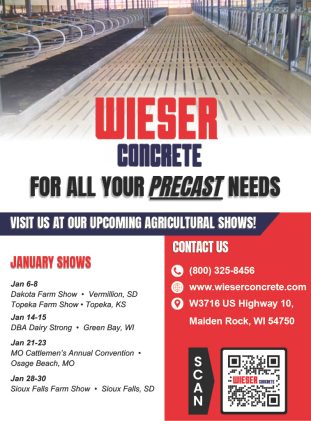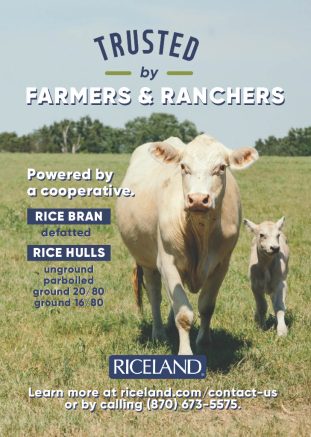Raising Dairy-Beef Feeder Calves

Raising/Feeding Dairy-Beef Feeder Calves
Many dairies are now breeding some of their cows—the ones they don’t raise replacement heifers from to beef bulls, generally using semen from Angus or Charolais. The beef-dairy cross calves are worth more as day-old calves than straight dairy calves, since the beef crossbreds feed out similar to beef animals.
Some backgrounders and feedlots now specialize in raising these crossbreds, according to Jonathon Beckett, PhD, a feedlot nutrition consultant based in California. His business is Beckett Consulting Services, Inc. in Fort Collins, Colorado. He has been working with feedlots for 16 years in the Southwest–Arizona and southern California—and the central plains, into the Texas panhandle.
“I have seen a larger number of dairy cross calves coming into feedlots over the past two years. As the number of Holstein cows being bred to Angus increases, the availability of straight Holstein steers has dropped dramatically, to the point where it is difficult to fill the yards with straight Holsteins,” he says.
“We are starting to feed more Angus-Holstein calves now in the Southwest, though not as many as what we are feeding in the central plains.”
The quality of these crossbred cattle has improved dramatically over the past four years. “When dairies first started doing this, they were just using any Angus semen and quality of the calves was not consistent. Now they have a more defined idea of what they are looking for, and what matches well with Holsteins,” he says.
“The quality is better from a performance standpoint, and for carcass traits. The cattle are marbling better and this leads to a more desirable carcass. The first thing we see on the carcass side is improved rib-eye area, improved muscling and better muscling conformation. This helps the packers. The surprising thing, for me, is that not only has the grade of these cattle not dropped, but in many ways it has actually gone up. I have had several lots of cattle that were 30% to 40% Prime, which is outstanding.”
The dairy influence does not hurt these cattle at all. “Holstein cattle tend to marble extremely well. The crosses are grading better now, which is a testament to the better selection of beef semen,” he says. This is a good mix, genetically.
One issue, especially in the Southwest, is that Angus cross calves do not tolerate heat as well as the straight Holstein calves. “We’ve had to change the way we manage those cattle, to try and mitigate the heat effect. Once you get past summer, however, they do phenomenally well,” he says.
In the central plains, cattle come in smaller—anywhere from 350 pounds to 500 pounds; 400 pounds is the common weight for these dairy cross beef calves. “Many yards are not set up for calves that small. These crosses also tend to be more predisposed to bulling activity so people have to be careful regarding the implant program for them. There have also been new regulations on implanting and re-implanting, and some restrictions there, but a person must be more aware of how the implants affect bulling activity,” he explains.
Feedlots need a strategy for this type of feeder calf, and also recognize the limitations. “One of the complaints from packers is dressing percent. When we started feeding the crossbreds we were expecting these cattle to yield the way a straight Angus would, but that’s not going to happen. Yield tends to be lower, but one feedlot owner in Colorado points out that the red meat yield and fabrication yield makes up for that. You actually get as much, if not more saleable product from these carcasses. So there is more research that needs to be done, to quantify what that is,” says Beckett.
“Some of the growth-promoting technologies could also be helpful in improving muscle conformation and yield for these cattle. As far as feeding them, I feed a different ration than I do to typical native cattle. I have a different feeding strategy, because they are different cattle. I am not a ‘least cost’ ration formulator for these crossbred cattle, because their performance is so much better when you fit it to what they handle best.” The improvement in performance more than makes up for a little extra cost for the ration.
“I feed them higher energy but also some long-stem roughage. I have also been experimenting with various products like probiotics and other feed additives that have a lot of value in aiding gut health and rumen function. Conversions on these cattle can be outstanding.” Ruminants are amazingly efficient if everything is working properly.
The crosses he sees on the beef side are either Angus or Charolais, and on the dairy side they are usually either Holstein or Jersey. I don’t see as many Charolais as I’d like; the Charolais-dairy crosses feed very well and grade well. One of the big values of the Angus-Holstein crosses is that you may get anywhere from 50 to 70% of them qualify for Certified Angus Beef premiums. There is a lot of value in this, and that’s why many dairymen prefer to use Angus semen.”
The feeding period will depend mainly on the age and size these calves come into the feed yard. “If they come in at 400 pounds they may be on feed for 310 to 320 days. Right now it’s hard to find feeder cattle (not enough supply to meet the demand) so it’s nice to have cattle that can be on feed a long time and fill the pens. These crossbreds are in demand because they are exceptional cattle,” says Beckett. If someone knows how to take care of and feed these cattle properly, they do very well.
“The way these cattle respond to hormones is different. Any animals with dairy genetics will have a different response to hormone, so the choice of implants will have a bigger impact on these cattle,” Beckett explains.
There are currently more dairy-beef cross feeder animals being produced, since many dairies are trying to bring in more revenue wherever they can. “With milk prices low, these calves are helping many dairymen with cash flow,” he says.
“For feed yards, however, people have to do their homework on marketing these cattle, because most of them are going on grids. Some grids are much more receptive to these cattle. If you put them on the wrong grid, you leave a lot of money on the table,” says Beckett.
Brad Johnson, Ph.D. (Professor, Meat Science and Muscle Biology, Texas Tech University, Department of Animal and Food Sciences) says there has been an increasing amount of research on these calves the past several years. Johnson had a PhD student working on some projects and has some of these studies are already published, including a Journal of Animal Science article.
“In one study we just completed, we had a variety of different types of calves—with different genetics and different calf-management strategies. We had an opportunity to get embryos from Simplot’s HerdFlex program, since we were interested in what these beef embryos would do in dairy cows. We put beef embryos in Holstein cows and Jersey cows in a father-son dairy operation with a Holstein and Jersey herd.”
Semen for the in-vitro fertilization to create those embryos was all from the same bull. “We bred that same Angus bull (Momentum, from Select Sires) AI to Holstein cows and Jersey cows. For a positive control, we bred our cow-calf herd here at Texas Tech to the same sire, using AI. These were all half-sibs in five different groups of calves,” he explains.
“The beef embryos in Holstein cows, the beef embryos in Jersey cows and the two AI groups, the calves were left on calf ranches on the dairies where they were born. They were reared in hutches, just like all beef-on-dairy calves would be reared now at a calf ranch. But the positive controls—the calves that were born to cows here at Texas Tech—were reared in a traditional cow-calf situation on pasture for about 190 days before we weaned them,” he says.
“We looked at everything from day one at birth all the way through the carcass data on all those groups. In addition, from the feedlot phase on, we had a 6th group which was straight Holstein steers.”
From a calf performance standpoint, the calves reared in a cow-calf situation and allowed to suckle their mothers for 190 days before weaning had the greatest growth rate. The Angus-Holstein cross calves did very well and were one of the best groups in the feedlot. “We got all the calves to 700 pounds and put them in a feedlot trial and fed them for 196 days. So it didn’t matter if they were Angus-Jersey crosses, straight Holsteins or Angus-Holsteins; they were all fed the same length of time,” says Johnson.
Compared to all the different combinations, the Angus-Holsteins did the best and were similar in performance to the all-beef calves in this test. From a carcass standpoint, they also did very well. “The Angus sire we used in all the different combinations is in the top 1% in the Angus breed for marbling (intramuscular fat). Any of the animals—whether they were beef-on-dairy crosses or straight beef animals—had great carcasses. We ended up with almost 60% Prime.” They graded well, and marbling was excellent.
“The only difference with the beef-on-dairy crosses–the Angus-Holsteins—was that they tend to have a lower dressing percentage than the all-beef animals. Even though their performance on a live basis, such as feed efficiency and daily gain, was very similar to the all-beef animals, because of the dairy influence on the dam’s side they tend to have lower dressing percent–about ¾ of a percent lower, compared to the all-beef animals,” says Johnson.
Some of the packers have been discounting dairy crosses about $20 to $25 per head, however.
“The red meat yield is actually very good. We’ve shown here in Texas that some of the best beef-on-dairy animals are actually better than the average beef animal. But on the lower end, some animals have more variation in carcass, so some packers use this as a reason to discount these animals. Right now, however, many of them do not have discounts because we are so short on cattle. If they find the right kind of beef-on-dairy calves, this cross is working very well for them,” he says.
“The best beef-on-dairy animals are better than the average beef animals, but there are variations. The bottom quarter are not much different than a straight calf-fed Holstein steer. We have been working on trying to understand that variation and why it occurs. Some of it is coming from the cow side. We tend to think that dairy cows (whether Holstein or Jersey) are very uniform, but phenotypically by their third breeding there is a lot of variation in frame size and muscling. Also, we may need to be more judicious in selecting the right semen to use on these cows,” says Johnson.
“We feel very positive about the beef-on-dairy crosses. We had a symposium in May 2022 and it was well attended. But the liver abscess issue is very real, especially in the central plains feedlots that are feeding these calves. We have seen instances where 75% of the calves in a single pen have liver abscesses. Conventional beef animals usually have only about 20 to 25% with liver abscesses. The beef-on-dairy cattle are worse for abscesses than the calf-fed Holsteins,” he says.
Paul Heinrich owns a feedlot in Colorado and feeds a lot of beef-on-dairy calves. The main complaints about these cattle, from the packers, is liver abscesses. “We’ve tried hot rations from birth and tried to tone it down, but what’s working for us now is that we use a lower protein ration that has more fiber in it,” Heinrich says.
“Most of these calves are on a pelleted ration from day one (at the calf farms that raise them) and when you take them off that pellet and introduce them to corn silage, or dry distillers grain, they just crash. It’s like a person eating steak all the time and then suddenly switching to pasta. The cattle don’t like it as well and sort through the feed in the bunks. They literally lose weight the first 30 days,” he says.
When they are nutritionally deprived/stressed, this is also when they are more vulnerable to viruses and bacteria. “You get bigger issues with that. So on these 400-pound calves we’ve focused on drastically stair-stepping them down from a high protein ration containing very little fiber to something that may be four to six% less protein with a lot more fiber. It might be alfalfa or some type of hay mixed into the ration. Then those cattle make the transition easier into a beginner feedlot ration,” says Heinrich.
“We are trying to source cattle that don’t have as much drop-off in performance when they go to the feedlot. We used to take cattle into the feedlot at 350 to 450 pounds and had too many illnesses and death losses in these light calves. Now we are keeping those calves in a smaller operation–keeping them in the calf environment until they are between 500 and 600 pounds rather than 350 to 450. Then they go to our backgrounding operation for 90 to 100 days; we’re not going to the feedlot now with those cattle until they are they are 750 to 800 pounds. By the time they get to the feedlot they’ve been eating a pretty similar ration and it’s not much of a transition,” he explains.
By that age, these calves are past the vulnerable stage when respiratory viruses and bacteria take hold. “We believe we are now in better shape regarding risks for death loss, liver abscesses, etc. These cattle are a little different than feeding straight beef calves or even straight Holsteins and we’ve tried everything. Some things work and some don’t.” It’s trial and error until you figure out something that seems to work most of the time.
“We’ve found that you’ve got to add fat to the ration and increase it to two% fat just to get these cattle to peak performance. It also makes a difference which kind of fat you use. I’ve been doing this for eight years and every day is a new challenge! It’s a work in progress,” he says.
If a person can fine tune it to where it works, these crossbred calves make it pay. “Calf prices are so high right now, however, that it’s tough to make it work; the margin for error in feedlots is slimmer than it’s ever been.”
By Heather Smith Thomas.
November 2023
Check out another Article focusing around Vaccinations for Dairy Calves




